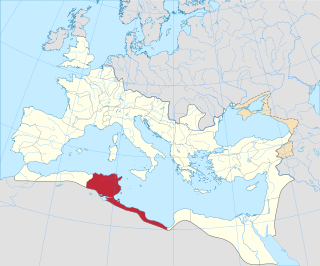Related Research Articles

Téboursouk is a town and commune in the Béja Governorate, Tunisia. It is located at 36° 27′ 26″N, 009° 14′ 54″E.

Bir El Hafey is a town and commune located at 34°55′48″N 9°12′00″E in the Sidi Bouzid Governorate, in Tunisia. As of 2004 it had a population of 6,405.

Avitta Bibba was a town in the Roman province of Africa Proconsularis. The town is tentatively identified with ruins at Henchir-Bour-Aouitta in Tunisia.

Aggar was a town and bishopric in the Roman province of Byzacena. One of two cities in the area, it left vast ruins that are now called (Henchir) Sidi Amara. These edifices are situated in the plain of Siliana, around 60 kilometres east of Maktar.

Djebba, also known as Thigibba Bure, is a town and an ancient archaeological site is located in Bājah, Tunisia. Djebba is an archaeological/prehistoric site in Tunisia located at latitude: 36°28'32.45" longitude: 9°4'53.54" in the Béja Governorate of northwestern Tunisia. The estimated terrain elevation above sea level is 355 metres located below the slopes of Djebel Gorra, 700 meters above sea level. Djebba also has a national park, which is the subject of a development project

Vallitanus or Vallis was an ancient Roman–Berber colonia in Carthage, Tunisia. The town is identified with ruins at Sidi Medien, where are located the remains of a Roman theatre, and a number of Roman inscriptions bearing witness to the town's name, and some local officials of the time can be found near the theatre.

Abthugni was an ancient city in Roman North Africa at present day Suwar (Henchir-es-Souar) in Tunisia. It was, in Roman times, in the province of Africa Proconsularis, Africa, and latter in Byzacena. In late antiquity Abthugni was also the seat of a bishop, and the diocese is a titular see of the Roman Catholic Church to this day.

Villamagna of Tripolitania was a Roman era settlement in what was the Roman province of Tripolitania. The town is identifiable with ruins at Henchir-Sidi-Abdein in today's Libya.

Aeliae or Æliæ was a Roman-era city in the province of Byzacena.

Vegesela in Byzacena was a Roman Era town tentatively identified with ruins at Henchir-Recba in modern Tunisia. The town was in the Roman province of Byzacena.

Auzegera was a Roman-Berber town in the province of Africa Proconsularis and in late antiquity Byzacena. It was a Catholic Church diocese.

Cissita was a town and bishopric of Roman North Africa, which only remains as a Catholic titular see.
Tagarata was a Roman era civitas of the Roman province of Africa Proconsularis. The ancient city has been tentatively identified with ruins at Bir-El-Djedidi, Tunisia.

The Diocese of Dices, is a titular see of the Roman Catholic Church. The location of the seat of the diocese is unknown for certain, but is perhaps identifiable with Henchir-Sidi-Salah, Tunisia. Henchir Sidi Salah was an ancient diocese in the Roman-Berber province of Byzacena.
Cabarsussi was an ancient civitas (municipality) and bishopric in the Roman province of Byzacena, that is tentatively identifiable with ruins at Drâa-Bellouan in modern Tunisia. The current bishop is Terence Robert Curtin, auxiliary bishop of Melbourne.

Muzuca was a Roman Town of the Roman province of Byzacena during late antiquity. The town has tentatively been identified with the ruins at Henchir-Besra in modern Tunisia. Very little is known of the city, though in situ epigraphical evidence gives us the name and that in late antiquity it achieved the status of Municipium.
The Diocese of Fissiana is suppressed Latin Church diocese and current titular see of the Catholic Church.

Grimidi was an ancient Roman town of the Roman province of Mauretania Caesariensis, located at 3.73031 35.87687 in North Africa. It flourished from about 30BC to about 640AD. Numerous ruins litter the site.
(Henchir) Sidi Amara may refer to the following towns in Roman North Africa, both in modern Tunisia, former bishoprics and presently Latin Catholic titular see :

The Diocese of Zella is a suppressed and titular see of the Roman Catholic Church. The diocese of Zella, is located in today's Tunisia.
References
- ↑ Emily A. Hemelrijk, City Patronesses in the Roman Empire Historia: Zeitschrift für Alte Geschichte Bd. 53, H. 2 (2004), pp. 209-245.
- ↑ Avioccalensis at catholic-hierarchy.org.
- ↑ Titular Episcopal See of Avioccala at GCatholic.org.